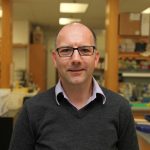
Gregor Neuert
Vanderbilt University
Determining mechanisms of regulation by antisense long noncoding RNAs at the Xist locus in embryonic stem cells using single-cell and single-molecule experiments
Abstract: Long noncoding RNAs (LncRNAs) are increasingly recognized as being involved in human physiology and diseases. Antisense RNAs are ubiquitous in the human genome. They have many possible mechanisms, but the single-cell and single-molecule experiments and analyses needed to test these mechanisms are lacking. We propose a combination of specific RNA fluorescent in situ hybridization (FISH) experiments of RNA transcripts, immunofluorescence of histone modifications, and subsequent quantitative analyses to test different mechanisms of antisense transcription. This approach was tested at the X-chromosome Inactivation (XCI) locus on the lncRNA pair Xist and its antisense transcript Tsix in more than 14,000 embryonic stem cells before and after two days of undirected differentiation. Our analysis provided evidence against many of the proposed mechanisms of antisense regulation at the Xist/Tsix locus while providing additional evidence for the importance of histone modifications. Interestingly, enrichment of these histone modifications extends beyond the site of transcription and is sensitive to the differentiation timeline of the cells. Quantification of biophysical properties of nascent RNA also suggests the presence of transcriptional condensates operating at the site of transcription ex vivo. This data demonstrates the power of quantitative single-cell and single-molecule image analysis when investigating noncoding RNA interactions. Our generalizable pipeline can be applied to further investigation of this locus and other transcripts across diverse species, cell types, and imaging modalities.
Biosketch: I am trained interdisciplinary with an M.Eng. in Technical Physics from Technical University Ilmenau (Ilmenau, Germany), Montana State University (Bozeman, MT), and at the Pacific Northwest National Laboratory (PNNL, Richland, WA) focusing on surface science and solid-state physics. Following graduation, I switched research fields to biophysics to obtain a Ph. D. in Physics in the lab of Dr. Hermann Gaub at Ludwig Maximilians University in Munich, Germany. After finishing my Ph.D. I switched fields again, focusing on underlying mechanisms of signal transduction and gene regulation as a DFG Postdoctoral Fellow in the laboratory of Dr. Alexander van Oudenaarden in the departments of physics and biology at MIT. I started my independent lab at Vanderbilt University, supported by an NIH Directors New Innovator Award in 2014 and as a Vanderbilt School of Medicine Basic Sciences Dean’s Faculty Fellow in 2021. My passion for science is to understand the molecular mechanisms of signal transduction and gene regulation using quantitative approaches. In my free time, I like to cook and bake, go hiking and camping, and enjoy the arts.